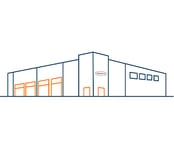With over 20,410 third-party logistics (3PL) providers in the US, according to IBISWorld, the task of finding the right manufacturing support logistics partner can be daunting.
That is, until you consider the specialized capabilities and experience required to perform manufacturing support logistics—especially in the areas of automotive and industrial manufacturing.
Manufacturing Support is a separate breed of logistics and many factors determine whether a 3PL has what it takes to provide your company with the inventory integrity, quality assurance and cost control required for a successful relationship in today’s world.
ODW Logistics has a long history of providing manufacturing support logistics to world-class automotive and industrial manufacturers. Here are the top ten considerations from the ODW Logistics team for choosing the ideal manufacturing support logistics partner for your supply chain.
Find support for your manufacturing operations.
1 - Industrial or Automotive Manufacturing Experience is a Must
Maintaining inventory integrity and meeting delivery KPIs in manufacturing logistics is so demanding that the pool of 3PL candidates is limited.
Logistics providers have to be able to deliver 99.99995% accuracy. Very few 3PLs have the experience and operations to provide that standard of quality.
Supply chain partners put themselves at risk when they don't understand the manufacturer’s business and how they, as a 3PL, contribute to that success.
The risks to production are great. Automotive and industrial manufacturers lose money for every second that a 3PL doesn’t perform their duties correctly.
Logistics partners in these fields that operate according to world-class standards are rare. They've typically come up through the ranks. Especially in the automotive sector. There are only a handful of 3PLs out there who have worked and partnered with the large car makers for 25 or 30 years. Oftentimes manufacturers have brought them along and made them a key partner in their business. These players are known entities.
When interviewing 3PLs, insist on credentials or you could find yourself paying a price for their learning curve.
Support your industrial company's growth with comprehensive logistics solutions.
2 - You Need a 3PL that Can Gather and Leverage Data
Having the capabilities to effectively handle end-to-end logistics is critical for a potential partner—but data drives decisions that optimize supply chain performance and minimize costs.
Today, a manufacturing support logistics partner has to have a good means for collecting data and experience using data effectively to drive change. The ideal 3PL uses leading-edge transportation, warehouse, inventory and order management systems to feed information into a manufacturer’s enterprise resource planning system.
This transparency into everything from inventory levels and outbound shipping status aids timely, informed decision-making.
Data-driven 3PLs do more than report. The good ones share where the data is leading with manufacturers and ask whether the findings sound right. If they do, they’ll offer advice for making the necessary changes.
That’s the recipe for supply-chain agility today. Look for a 3PL with the data, the expertise and the collaborative culture to make smart, fast decisions that can make a positive impact.
See how data integration improves supply chain performance.
3 - Look Closely at Labor and Automation Resources
With today’s shortage of warehouse workers, logistics providers have invaluable access to labor pools. Their trained workforce of permanent workers and ability to bring on temps to handle demand surges is a value to manufacturers who would otherwise find themselves dealing with the chore of hiring and retaining scarce workers.
Labor can still be a big “if” that can impact manufacturers lines when a 3PL is short-handed. For that reason, 3PLs who have invested in automation are the most reliable option in any labor market.
Automation in the form of conveyance, robots or automated storage and retrieval systems helps them provide predictable capacity and gives them the ability to scale to meet your needs. When you need to meet a volume surge, an automated 3PL can schedule an extra shift or run overnight to meet your needs—without paying workers overtime.
Automation brings speed and accuracy benefits to manufacturers without the burden of a CapEx investment—or the full cost of a CapEx investment. Perhaps most importantly, manufacturers can leverage the 3PL’s supply chain automation expertise to avoid costly beginner’s mistakes.
Pay close attention to how a third party staffs and automates. Once you’re working with them, their capacity largely determines yours.
Find automation solutions that increase labor productivity and decrease risk.
4 - Third Party Providers Need to Have a Wholistic View
Today’s consumer-oriented supply chain puts more responsibility on third-party providers to ensure the satisfaction of manufacturers’ end customers. As an extension of a manufacturer’s business, a 3PL needs to know the customer’s customer.
The best manufacturing logistics providers understand it’s not about how they perform their service for the manufacturer; it's how the end result impacts the manufacturer’s customer.
Today, manufacturing 3PL partners must fuse their operations and their purpose to the manufacturer’s. That starts with understanding developed during the initial discovery phase and continues through a 3PL’s commitment to knowing a manufacturer’s business and challenges.
ODW’s Roadmap to a Supply Chain Advantage provides an example of how a wholistic view can be developed and maintained.
Transform your supply chain into a driver of value.
Wholistic Supply Chain Planning
- Discover: Start with understanding manufacturers’ business goals, challenges and objectives. Analyze the current supply chain, define success and determine opportunities for improvement.
- Design: Engineer the optimal solution for service improvement and cost control. Implement efficiencies, automation and integrations to drive labor savings and scalable growth. Formalize the ideal supply chain solution for meeting and exceeding business goals.
- Implement: Employ a cross-functional, dedicated project management team for delivery and application of supply chain solution. Transition to steady-state following go-live. Emphasize communication, transparency, risk analysis and mitigation throughout the process.
- Improve: On-going, in-person site observation. Scheduled team meetings to review successes and challenges. Formal program promoting continuous innovation.
Wholistic, customer-focused supply chain planning starts with a 3PL’s leadership. Not only do leaders need to champion a discovery process for learning customers’ businesses, but they should also be able to demonstrate success stories to manufacturers.
Ask 3PL leaders how often they walk the shop floor with manufacturers to discuss successes and challenges? It’s a daily routine with some ODW customers.
5 - Pay for Quality or Pay for Mistakes
Quality is a non-negotiable in delivering contract logistics services. Especially in the automotive and industrial sectors, 3PLs have to be able to perform near 100% when it comes to inventory integrity and established KPIs.
Inventory must be delivered where it needs to be, when it needs to be there, in the right quantity, in the right quality and in the right container. That is the industry standard in manufacturing logistics.
Today’s supply chain challenges make that more challenging than ever—while the risks to production and profitability remain the same.
Costly mistakes make a low-cost leader a liability in choosing a manufacturing logistics partner. The reality is that a 3PL that is a low-cost leader is unlikely to have the capabilities to meet the high-quality expectations prevalent in automotive and industrial manufacturing logistics.
Manufacturers today value quality. Most realize they need to make sure that 3PLs have the technology and automation capabilities for delivering high performance integrated logistics solutions.
Also crucial is they need to see a proven track record with other manufacturers from their sector. Expertise is a rare commodity; however, and manufacturers should expect to adjust their value line accordingly. It can be a mistake to buy low and expect high quality all the time.
6 - Prioritize Tenured Leadership and Staff
A 3PL’s vertical experience is evident in the tenure of its people. Manufacturing support logistics is unusual because people tend to stay put. For example, ODW Logistics has associates that have been with the company for 20-40 years.
Experience is also critical in line-side assembly. This requires associates who can toggle two masters: the 3PL that employs them and the manufacturer whose plant they are physically working in.
Check a 3PL’s people for permanent workers. An over-reliance on temps can threaten quality.
See why you get more from your 3PL with ODW Logistics.
7 - Seek a Culture of Transparency
The speed of change and accent on customer satisfaction necessitates open and real-time information sharing of supply chain events. In today’s world, bad news shared quickly can be good news if it enables customers to adjust production to avoid additional labor charges or a production line going down.
A transparent culture is a success culture for a 3PL. The more openly a 3PL communicates about the good, bad and indifferent, the more powerful the partnership with a manufacturer becomes. Being very transparent about successes and challenges facilitates collective action that leverages both parties’ respective areas of expertise: manufacturing and supply chain.
Additionally, transparency helps a 3PL improve every day what they do on behalf of clients. The data is there to correct problems or anticipate challenges faster and more definitively than ever. That speed depends on partners’ commitment to continuous sharing and problem-solving.
It’s worth it to ask a 3PL for an example of how well they collaborate with other manufacturers in their day-to-day. What’s their approach to sharing bad news?
8 - Ask How a 3PL Incentivizes Innovation
In today’s rapidly changing supply chain, continuous innovation is a mandatory. A team of experts who are aided by technology and motivated by well-conceived programs is paramount.
Continuous innovation is made possible by data pointing to opportunities and establishing KPIs that can be met and beaten. If you don’t measure performance, you can’t improve it. A 3PL’s systems provide data, but that data must be fed efficiently to manufacturers’ own high-performance enterprise systems.
Aside from measuring, it takes teams who are incentivized to identify inefficiencies and strategic opportunities that control costs and improve service delivery.
3PLs that are committed to continuous innovation have concrete initiatives that spur their employees to solve problems and develop programs.
9 - Don’t Assume 3PLs Have an Implementation Process
Manufacturing logistics is unforgiving. A break in production can cost hundreds or even tens-of-thousands of dollars per hour in labor.
The best manufacturing logistics providers have processes that are thorough and painstaking in order to avoid shortages, delays or product inconsistencies. It’s the nature of the business.
An example is when a 3PL transfers inventory. The 3PL wants to make sure that they receive it as a brand-new product. They don’t want to just transfer it in a system and then expect it to be correct. Integrity is paramount. A 3PL should want to count it, look at it, shelve it, put it in their system themselves and then be responsible for it.
To ensure integration goes right, testing, testing and more testing is required. When integrating with clients, the most powerful thing a 3PL can do is test their systems until they break. When you do everything you can to break a system, then you’ll know how to fix it if it does break.
Not knowing how to fix something when you’re actually in production, creates crises and the dollars go down the drain. The more a 3PL can test to break the system, the better served everyone is and ultimately the more control a manufacturer can have.
Save 20–30% with ODW's integrated logistics solutions.
10 - 3PLs that Excel in Transportation Management Are Gold
The team at ODW often sees the largest opportunity to grow profits for manufacturers coming from transportation management.
The opportunity to save money through strategy far outperforms a hyper-focus on rate negotiations. In fact, customers in ODW Logistics’ transportation management program realize 8-13% freight savings in their first year.
Save 8–13% with ODW's outsourced transportation management.
Pillars of Transportation Management Planning
- Transportation Network Analysis: This involves a dive into a manufacturer’s transportation data to identify gaps in the current network and inform alternative freight management solutions that deliver cost controls, speed, and service advantages.
- Mode and Carrier Selection: A solution is designed to identify the optimal mix of carriers, brokers, and dedicated assets to tender freight for complete visibility, control, and flexibility.
- Freight Consolidation: A manufacturer’s freight can be combined with other shippers’ freight to create full truckload shipments. A multi-client consolidation program delivers flexibility, improves speed to market, and helps manufacturers achieve scale and cost savings.
- Transportation Management Technology: A leading-edge transportation management system (TMS) serves as an indispensable control tower to optimize manufacturers’ freight. Features like real-time alerts, shipment tracking, a comprehensive customer portal, and business intelligence tools enable visibility and control.
- Dedicated Team: Technology guided and augmented by a dedicated team is necessary for responsive execution and proactive improvement initiatives. Expertise aided by technology provides a definitive advantage in today’s supply chain.
ODW Helps World-Class Manufacturers Build World-Class Supply Chains
Want to see what a successful partnership looks like in manufacturing logistics? Read this case study to get an idea of potential transportation savings, and then talk to the ODW Logistics team about what a custom supply chain solution could look like for you.
ODW Logistics
Since 1971, we’ve been providing warehousing, distribution, and transportation solutions for hundreds of brands. We operate as an extension of your business to control costs throughout your supply chain that deliver you a competitive advantage over your competition.RECENT POSTS
Shipping to Walmart involves understanding and navigating stringent logistics requirements. As the world’s largest retai...
Jul. 25, 2024 09:37 AM
John Guggenbiller, the retiring president of ODW LTS, was honored with an induction into the Greater Hamilton Chamber of...
Jul. 03, 2024 09:15 AM
ODW's Retail Consolidation program consolidates your shipments into more efficient full truckloads or combining them wit...
Jul. 01, 2024 09:47 AM











